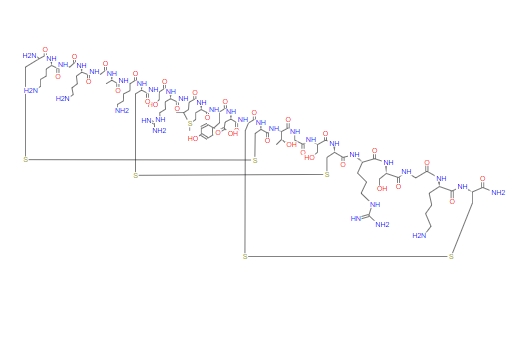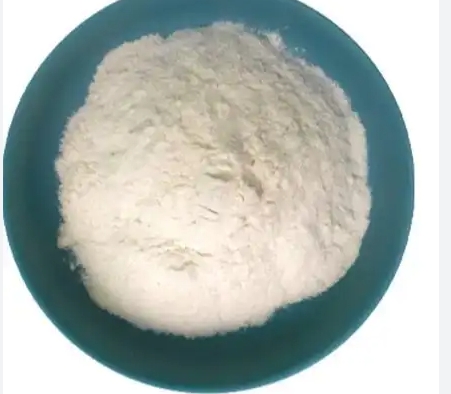Ziconotide Polyacetate, marketed as Prialt, is a 27-amino acid, three-disulfide peptide toxin synthesized from the South Pacific Marine snail Conus magus. It is the first of a new class of neurotherapeutic drugs, belonging to N-type calcium channel blockers (NCCBS). It selectively binds to N-type electrosensitive calcium channels in dendrites and axon terminals, thereby inhibiting initial nociceptive stimulus afferents. It is indicated for patients with severe chronic pain who require intrathecal treatment and who have poor tolerance or poor efficacy to other analgesic methods, such as systemic analgesics or intrathecal morphine. "Intrathecal Ziconotide Polyacetate is effective for the treatment of postherpetic neuralgia, phantom limb pain, HIV-related neuropathic pain, refractory cancer pain, and postsurgical pain."
Ziconotide Polyacetate is a synthetic ω-MⅦA conotoxin originally reported as a polypeptide component of a hallucinogenic conotoxin. Its amino acid sequence consists of 25 amino acids: Cys-Lys-Gly-Lys-Gly-Ala-Lys-Cys-Ser-Arg-Leu-Met-Tyr-Asp-Cys-Cys-Thr-Gly-Ser-Cys-Arg-Scr-Gly-Lya-Cys-amiSe. The pharmacological activity of this polypeptide is dependent on intact disulfide bonds, and these connections are key determinants of molecular structure. The 3D structure of Ziconotide Polyacetate was obtained by NMR. The disulphide bonds C1-C16, C8-C20 and C15-C25 fold the polypeptide into an ω-junction, showing the characteristics of the ω-family. In addition, a 3-strand β-fold is present in the structure, which further enhances its stability. The surface of Ziconotide Polyacetate exhibits a high degree of hydrophilicity due to the interaction of charge and amino acid polarity.

The structure of Ziconotide Polyacetate shows its potential as a drug: firstly, the length of the amino acid sequence and its folding to form the active structure provide new opportunities for artificial synthesis and clinical application; Secondly, the hydrophilicity of the molecule makes it easy to form a hydrated drug form; Third, the stability of Ziconotide Polyacetate may be affected by oxidizing agents or reducing agents such as oxygen because of the disulfide bond and the methionine at position 12; Finally, its relative size and hydrophilicity limit its ability to penetrate tissues, meaning that Ziconotide Polyacetate can be delivered directly to the cellular region of targeted therapy for optimal results. Pharmacological action
Intrathecal Ziconotide Polyacetate is effective in some rodent models of pain, such as inflammatory pain and chronic neuropathic pain. In addition, these results also clearly point out that Ziconotide Polyacetate achieves its analgesic effect by acting on the N-VSCC target.
The clinical mechanism of action of this drug is unknown. Animal studies have shown that it can bind to and block N-type calcium channels in the superficial primary nociceptive afferent nerve in the spinal dorsal horn, thereby inhibiting the release of excitatory neurotransmitters from the terminals of primary afferent nerve to resist the perception of injury.

The structure of Ziconotide Polyacetate consists of three disulfide bonds, forming a compact and rigid structure and containing four asymmetric loops. This allows it to bind to NCCs with high affinity and selectivity, thereby reversibly blocking the influx of calcium ions and inhibiting neuronal excitability and neurotransmitter release. Animal studies have shown that Ziconotide Polyacetate is able to reduce pain in an experimental rat model in a reversible and dose-dependent manner. In addition, Ziconotide Polyacetate may have specific effects on pain receptors. When applied directly to the site of nerve injury in rats, Ziconotide Polyacetate reduced thermal hyperalgesia and mechanically triggered pain, but had no effect on normal rat nerves. Ziconotide Polyacetate did not lead to tolerance of the analgesic effect when administered to rats by intrathecal injection. Unlike morphine, intrathecal injection of Ziconotide Polyacetate did not induce respiratory depression in rats when an antinociceptive dose was used. "After intrathecal administration of Ziconotide Polyacetate (1, 5, 7.5, or 10μg per hour) in 24 patients with chronic pain, no dose - or time-related changes in respiratory rate, pulse, and blood pressure were observed, and no changes in physical or mental assessments were noted." In vitro studies showed that Ziconotide Polyacetate partially blocked the release of norepinephrine without affecting the release of GABA and glutamate, and did not block nicotinic acetylcholine receptor ion channels in neurons.
Post time: 2025-07-16
